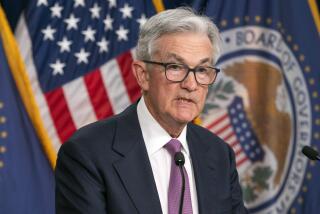Maybe, Just Maybe, There’s a Message Here : Report of low quarterly growth should grab Fed’s attention
The surprising slowdown in U.S. economic growth during the first quarter has unsettled financial markets. At 2.6%, the increase in the nation’s gross domestic product was almost a full percentage point short of the 3.5% expected by many analysts and was less than half the 7% increase posted in the fourth quarter. At the same time, if the number wasn’t exactly thrilling it was respectable: After all, economic growth proved to be steady in the first three months and the new statistics reveal that the economy is not overheating.
Nevertheless, the markets are in turmoil--as they seem to be so often lately. The ghost spooking the market this time is said to be the widening fear that the Federal Reserve Board will raise interest rates for the fourth time this year--perhaps as soon as next month. Adding to the jitters is the concern that a strengthening of the German mark and the Japanese yen against the dollar--meaning that a dollar will buy fewer marks and yen--will put additional pressure on the Fed to increase interest rates in hopes of attracting more foreign investments. Indeed, the Fed intervened in foreign exchange markets on Friday to bolster the dollar.
Clearly the Fed is hyperactive now. Three times since February, Fed Chairman Alan Greenspan opted for a preemptive strike against inflation that also aimed to wring out market speculation; this took the form of raising the short-term interest rates that the Fed charges banks. The last thing needed now is yet another move upward, for that might drive up long-term interest rates even more. And that in turn would mean higher borrowing costs for consumers, who already have seen mortgage rates spike up just as the spring home-buying season was beginning.
Higher long-term interest rates could depress home sales at a time when economic data gives further evidence of weakening in the economic surge that closed out 1993. Although sales of new homes jumped 11.1% in March, the biggest increase in six months, personal income rose only 0.6% last month and consumer spending increased only 0.4%.
In recovering from its worst slump since the Great Depression, California has lagged badly behind most of the rest of the nation. Before the Fed began punching up interest rates some analysts saw the state as being on the verge of a dramatic comeback. But such hopes were based on forecasts of mortgage rates below 8%. Now fixed rate, 30-year home loans are above that.
The nation thus has begun an economic recovery without California. But it has long been recognized that any recovery might stall without a resurgence in California, which accounts for about 15% of the gross domestic product. The Federal Reserve Board’s interest rate game plan is aimed at keeping the national recovery under inflationary control, but its castor-oil prescriptions are not the right remedy for California. The Fed would be wiser to understand that a moderate national recovery that includes this state is far more sustainable than one that leaves behind a recessionary California, gasping for air.
The Fed must be reminded that the first-quarter GDP figures give evidence that the economy is not overheating and inflationary pressures are not immense. It should forget about any more interest rate hikes for the time being.
More to Read
Inside the business of entertainment
The Wide Shot brings you news, analysis and insights on everything from streaming wars to production — and what it all means for the future.
You may occasionally receive promotional content from the Los Angeles Times.










